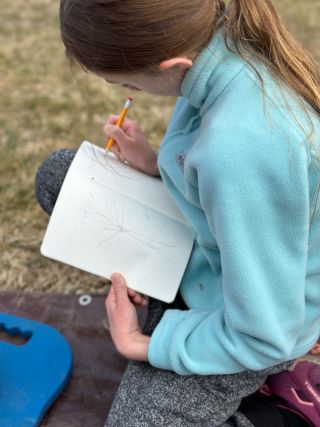Environment
Get Outside and Play (and Learn!)
Regular outdoor education improves curiosity and connection to nature.
Posted May 12, 2023 Reviewed by Davia Sills
Key points
- Parents of children who attend outdoor education classes report that they are more curious, take more risks, and appreciate nature more.
- Children who attended nature-based classes scored significantly higher in each of these areas than children who did not.
- These results were true both in parent report and in self-report.
- Even outdoor education sessions of just 90 minutes per week can improve children's development.
As spring blooms and the days turn longer, warmer, and more pleasant, I am excited to spend more time outside. I am also anxious to encourage my children to do so as well. I know that playing outdoors will help with their overall behavior (Hinkley et al., 2018) and social skills (Hinkley et al., 2017) and will increase their levels of physical activity (Keane et al., 2017 ).
In many countries, outdoor play is encouraged year-round, regardless of weather, temperature, or amount of light (see McGurk, 2017). Some educators in the United States are picking up on this mentality and are creating forest schools and other nature-based education programs for children. One such nature-based program that is close to where I live and work is the Nature at Heart School. I wanted to know what kinds of benefits might result from participating in outdoor education classes, even if it is just once a week for an hour and a half or so (regardless of weather).
In order to assess the impact of participation in an outdoor education program, we recruited five families of children between the ages of 5 and 8 who participated in a winter session at the Nature at Heart School and 11 children between the ages of 5 and 11 who were from the same locale but were not (and had not ever been) in any nature-based classes. In addition to similarities in age and residency, the participating families from each group had very similar incomes, education levels, and ethnic backgrounds.

Two undergraduate research assistants observed the five children in the nature class over the course of 5 weeks of a winter-class session and interviewed them at the end. The students also interviewed 11 children who had not participated in the outdoor education classes. The children were observed and asked questions to assess their self-reliance, self-regulation, curiosity and risk-taking, motor skills, and appreciation of/connection to nature. The results comparing the two groups of children were published in my last blog entry. In the current entry, I will focus on the data provided by the parents, as well as the comparison between parental reports, children’s self-report, and class observations.
The parents of both groups of children were presented with a Google Form comprised of approximately 70 questions designed to assess their children’s development in the same five areas mentioned above. Sample questions to measure self-reliance included rating the frequency with which their children ask for help with various tasks (e.g., household tasks, academic tasks, basic daily tasks), rating their children’s ability to self-entertain, and rating their children’s comfort level with things like solitary play, exploring independently in new situations, and participating in class discussions at school.
To assess self-regulation, we asked questions such as how frequently their children follow the rules at home and at school, how important it is to their children to follow the rules, how well their children control their temper in challenging situations (e.g., when something important is taken away, when they get in trouble, or when they lose a game), and their children’s ability to overcome anxiety in new situations.

Items designed to measure curiosity and risk-taking included questions about the children’s comfort level with taking risks while playing outside or when on an outdoor hike, and about their comfort level when interacting with or approaching other children they don’t know, asking questions of their teachers in school, or speaking to strangers in customer service roles. Parents also reported how frequently their children ask questions about nature in general, when playing outside, and when on hikes.
Regarding motor skill development, parents were asked questions such as how comfortable (and how skilled) their children are with tasks that require physical strength and endurance, how athletic their children are, how strong their hand-eye coordination is, and how many sports they play.
Finally, to tap into their children’s appreciation of and connection to nature, the survey asked how frequently their children play outside, how much the weather impacts their children’s decisions to play outside, how much interest their children show in nature when playing outside, and how frequently their children point out, play with, or collect natural objects (e.g., sticks, insects, rocks, dirt, plants). They were also asked to rate their children’s enjoyment of going on nature walks or hikes, of getting dirty from playing outside, and of playing in the rain.
For each question, parents provided scores from 1 (low end) to 6 (high end). We then added scores from all the rated questions within each section to determine the total scores for all five categories. Comparisons were made between children who attended outdoor education classes and those who have not for each of the total scores. Within each category, questions that showed large discrepancies in average scores between the two groups were also compared.

Results indicated that while total parental ratings did not differ for the self-reliance, self-regulation, or motor skills categories, children who attended nature-based classes were reported by their parents to have significantly higher levels of curiosity and risk-taking and a significantly higher appreciation of and connection to nature than children who had not ever participated in any outdoor education classes.
A more detailed analysis of specific items that differed between the two groups found that the children in the outdoor education classes were reported by their parents to have a significantly higher level of comfort with solitary play and a significantly higher level of curiosity about the natural world. They spend significantly more time playing outside on non-school days. They were also reported to be significantly more likely to pick up litter if they saw it, to enjoy nature walks or hikes, to enjoy getting dirty from playing outside, to play with natural materials outside, and to show interest in nature when playing alone outside.
When comparing data from the parental reports to the data from the child reports and child observations, there was some clear overlap. The children and parents were in agreement that curiosity and risk-taking, and an appreciation of and connection to nature were higher in children who take outdoor education classes. They were also in agreement that children in the nature-based classes were more likely to ask questions and want to learn about things in nature and that they were more likely to enjoy playing in the dirt or mud and collecting objects in nature. Children from the nature-based classes reported that they were more likely than the group who didn’t attend classes to enjoy climbing rocks and playing near lakes, rivers, or streams, which aligned with the observations of them doing precisely these types of things during the nature-based classes.

These samples are small, and it must be acknowledged that it is possible that these groups were different to begin with. However, their similar demographics lend more credence to the idea that nature-based classes make a difference. Future research will use a within-subjects design to compare children’s levels of self-reliance, self-regulation, etc., before they begin nature-based classes to after they have taken a session or two. We are confident that the classes will improve self-reliance, curiosity, and risk-taking, and an appreciation of and connection to nature, as suggested by the results here.
It is understandable that parents may not be able to enroll their children in full-blown forest schools or spend countless hours outdoors or on extensive hikes with them. However, these results suggest that even short sessions of time encouraging children to indulge their natural curiosity and playful spirits outside can and will do wonders for their development.
A special thanks to Diamond Diaz and Cece Cream for their hard work on data collection and entry for this study and to the participating teachers, parents, and children, without whom this study would not have been possible.




